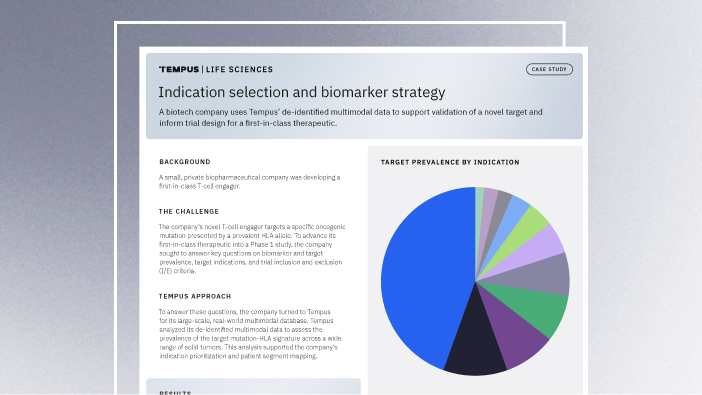-
PROVIDERS
New MRD Medicare Coverage for Select Indications*
*When coverage criteria are met. Additional criteria and exceptions for coverage may apply.
-
LIFE SCIENCES
ENROLL NOW
Tempus’ patient-derived organoid screens
Evaluate the efficacy of your preclinical compounds using fixed organoid panels designed for diverse therapeutic applications -
PATIENTS
It's About Time
View the Tempus vision.
- RESOURCES
-
ABOUT US
View Job Postings
We’re looking for people who can change the world.
- INVESTORS
10/02/2025
Q&A: A chief data officer’s view on powering precision medicine with RWD & AI
In this Q&A, Melisa shares her insights on the current state of healthcare data, Tempus’ approach to building its multimodal library, and how AI is making the vision of a learning healthcare system a reality for researchers and providers.
Authors
Melisa Tucker,
Chief Data Officer, Tempus

Chief Data Officer, Tempus

The healthcare industry is at a pivotal moment, with unprecedented amounts of data being generated daily. The convergence of genomic sequencing, novel therapies, and artificial intelligence (AI) presents a unique opportunity to transform this data into actionable insights that may improve patient outcomes. To realize this potential, we need a robust strategy for managing, interpreting, and applying complex, multimodal information at scale.
Melisa Tucker, Chief Data Officer at Tempus, has spent her career at the intersection of healthcare, technology, and data. With experience spanning venture capital, management consulting, and leadership roles at Flatiron Health and Verily Life Sciences, she brings a unique perspective to her role. At Tempus, she leads the strategy for ensuring all products and services are powered by high-quality, differentiated data.
How would you characterize the current role of data in the healthcare industry? |
Tucker: It could not be a more exciting time to be in healthcare. When you consider the advances over the last two decades—from the adoption of genomic sequencing as a standard of care to the introduction of new therapeutic classes like immunotherapies—the oncology landscape has been revolutionized. Now, we are layering in the power of AI to simplify, streamline, and empower processes that have traditionally been manual and inefficient.
We are at a point where massive amounts of data are being generated, and for the first time, we have the technological ability to bring it all together and make sense of it at the moment it’s needed. It feels like healthcare is poised to lead other industries in demonstrating the real-world impact of AI, moving from a question of if we should use it to how we can best use it to solve our most pressing problems. |
What are your key strategic priorities to ensure Tempus has the “right” data to power its mission? |
Tucker: My role is to ensure that all of our products and services are powered and differentiated by data. Whether it’s our diagnostic tests, our data licensing business, or our AI applications, data is the core foundation underpinning everything we do. Each product has unique data requirements—some need it in near real time at a key decision point in the patient journey, while others require specific data modalities that go beyond standard clinical information.
My team focuses on several key areas. First is data access; we invest in technology to make the process of sharing and receiving data from health systems simple, secure, and controllable. Second, we have an underlying data platform that brings together all of this information and makes it usable and analysis-ready. This involves processes like de-duplicating patient records, linking to external data sources, and using AI to help organize and interpret vast amounts of unstructured data. And finally, delivering that data in the right way to users of the data, along with research-ready data and tools that shorten the time to insight. |
How does Tempus leverage AI to transform its multimodal RWD into actionable insights for researchers? |
Tucker: We are actively using AI in a number of ways, and it’s embedded in our company culture. One of the most significant applications is making sense of our vast multimodal data library. Historically, this required trained human abstractors because of the complexity and clinical nuance involved. We are increasingly leveraging AI tools to enable the analysis of unstructured data for research purposes, and we are building towards a future where AI tools, when appropriately tested and validated, can augment or even largely replace manual abstraction efforts that are slower and more expensive.
For researchers, this is transformative. Instead of starting from a blank sheet of paper, our tools can generate a first draft of an analysis almost instantaneously. This allows highly skilled experts—statisticians, epidemiologists, and data analysts—to use their training to refine, edit, and build upon that foundation. It dramatically shortens a process that might have taken weeks or months, freeing up researchers to focus on generating more insights, particularly at the individual patient level. The ability to do that for each patient as they walk in the door is the holy grail of precision medicine. |
What does a “learning healthcare system” mean to you, and how is Tempus helping to make this vision a reality? |
Tucker: A learning healthcare system is the ability to use data and insights from past patient care to improve the quality of care for every single patient who follows. It means learning from every patient experience to contribute to better care in the future. For years, this has been a goal in healthcare, but data silos, unstructured data challenges, and the difficulty of integrating different data types—like pathology images, genomic data, and clinical notes—have been major barriers.
To make this a reality, you need data to be accessible and consumable at the moment of care. You also need a system that continually aggregates new data, so the insights provided a month from now are informed by all the patients seen in the interim. At Tempus, we are building the foundational data platform to break down these silos. By integrating this platform with tools that surface the right information to a physician within their workflow, we can help them make more informed decisions and ensure care is constantly improving. |
|
“At Tempus, we are building the foundational data platform to break down these silos. By integrating this platform with tools that surface the right information to a physician within their workflow, we can help them make more informed decisions and ensure care is constantly improving.” – Melisa Tucker, Chief Data Officer, Tempus |
Tempus acts as both a generator of molecular data and an aggregator of clinical, imaging, and claims data. Can you explain the strategic importance of this dual approach? |
Tucker: This dual approach is one of our key differentiators. As one of the largest generators of molecular data in oncology, we have more control over the quality and depth of that data. We can make decisions about what information is important for both patient care and research, and as we discover new algorithms or predictive biomarkers, we can provide those insights back to the treating physician and study them across a broad population.
This approach also builds trust. When we partner with health systems, they often have a longstanding relationship with us through our sequencing business. This provides a foundation of trust to build upon for broader collaborations around AI applications, clinical trial matching, or care gap identification. It allows us to expand the relationship from sequencing a specific patient population to providing insights across all of their patients, linking our deep molecular data to the rich clinical context—like treatments, outcomes, and physician notes—found in the aggregated records. |
A powerful real-world dataset must be both complete and diverse. How does Tempus ensure its data is robust enough to inform critical decisions and representative enough to address health equity? |
Tucker: We spend a lot of time thinking about data quality. This includes validating key data elements like clinical outcomes, characterizing what we have and what’s missing, and measuring the performance of our curation, whether it’s done manually or with AI. We believe in transparency, which is why we publish on the quality of our data and enable users to trace data points back to the source text. We also focus on ensuring the data is “fit for purpose” for each specific research question, which may involve linking to external data sources, such as claims data, to create a more complete picture.On representativeness, it’s critical to look at the makeup of the patient population. We work with more than half of all treating oncologists in the country, and our network includes a broad mix of community and academic centers that closely mirrors the distribution of where patients are receiving care in the real world. By its nature, this type of RWD is inherently more diverse than data from clinical trials or specific registries. Building a dataset of hundreds of thousands of sequenced patients with their corresponding clinical data is a massive step toward understanding the natural history of disease in a truly representative population. |
|
“Building a dataset of hundreds of thousands of sequenced patients with their corresponding clinical data is a massive step toward understanding the natural history of disease in a truly representative population.“ – Melisa Tucker, Chief Data Officer, Tempus |
Given the sensitive nature of patient data, what is Tempus’ philosophy on data privacy and ethics? |
Tucker: This is the most fundamental aspect of our work and underpins everything we do. We are governed by HIPAA, but our commitment goes further. It is critical for us to track how we receive data, what the appropriate uses are, and what our specific obligations are to individual sites and contracts. We de-identify protected health information (PHI) as early in the process as possible and use strict, role-based access controls to limit internal use of PHI.
Philosophically, we believe that the providers who generate data own their data. We act on their behalf, and if we create derivative data products through curation or processing, we give that value back to them. We don’t ask for data exclusivity because we see data as a renewable resource. When handled appropriately, it can be used to learn, improve patient care, and help the entire ecosystem. |
Can you share an example of how Tempus’ AI and data solutions have enabled a learning loop that improved patient outcomes or accelerated research? |
Tucker: A great example is how we use a patient’s combined clinical and molecular data to provide specific, targeted recommendations at each moment in time. This could be identifying a clinical trial match for a patient—even if the trial isn’t yet open at their site—or surfacing guideline-based care suggestions to consider in their treatment journey. This information helps physicians better target treatment for each individual patient.
This process also accelerates the accrual of patients to clinical trials, which directly benefits our life sciences partners and the broader research community. Our entire portfolio of AI applications is an example of this learning loop in action, where we leverage real-time, multimodal data to provide actionable recommendations to physicians that can have a direct and positive impact. |
What support does Tempus offer researchers in terms of leveraging your data and AI models? |
Tucker: Our Tempus Lens platform provides a set of tools that are among the most advanced in the industry. It’s not just a place to store data and create cohorts; it allows researchers to collaborate and dive deeper into the data. For example, you can view de-identified source documents and start asking questions about information that may not even be in the curated data model yet, such as qualitative aspects of a physician’s note.
This capability is unique and can spur new research questions and use cases. It creates a continually reinforcing feedback loop where researchers can explore the data, identify new variables of interest, and then request that they be curated at scale using AI, unlocking even more value from the data. |
How does Tempus ensure researchers can seamlessly integrate their own data into the Lens platform? |
| Tucker: A really powerful aspect of Lens is the ability for researchers to bring in their own data. Our broader vision is for Lens to be a platform where our data capabilities can be applied to any dataset a researcher wants to use. We are already seeing partnerships where we take multiple data types and datasets—some from the client, some generated by Tempus—and bring them together in an interoperable way. This allows for analysis across datasets and unlocks new insights that would be impossible to generate from a single source. We are really just starting to scratch the surface of what’s possible here. |
Looking ahead, what emerging data technologies or methodologies do you see as having the most significant impact on the life sciences industry? |
Tucker: Beyond the broad impact of large language and multimodal models, I believe we will see a significant impact from AI-powered diagnostics. This means moving beyond the results of a single test and instead using the totality of a patient’s data—combining multiple data points from different moments in their care—to identify and predict valuable insights. We are already starting to do this in cardiology with our ECG AI products.This is the true promise of precision medicine. It’s about understanding that every patient is different and using foundational models to recognize patterns across a much broader scale than was ever possible for a human to see. This will help us predict significant health events well in advance and invest more in preventative care. |
|
“This is the true promise of precision medicine. It’s about understanding that every patient is different and using foundational models to recognize patterns across a much broader scale than was ever possible for a human to see.” – Melisa Tucker, Chief Data Officer, Tempus |
For life sciences leaders considering data collaborations, what are the most important questions they should be asking about a partner’s data and technology platform? |
| Tucker: A data partnership should be broader than just answering a single question. I would encourage leaders to ask about the sustainability and growth of the data. Does the partner have a differentiated way to generate or access data that will continue to grow, or are they reliant on third parties in a way that could be disrupted?
Second, consider the dimensionality of the data. In the future, unstructured text, raw imaging, and pathology will become increasingly important as we develop better tools to analyze them. A partner should have access to this type of high-dimensional data. Finally, and perhaps most importantly, ask about the partner’s investment in making the data usable and actionable. Having data that just sits in a platform is not enough. The real value comes from a partner who has spent time thinking about how to integrate that data into decision-making and deliver it to the right person at the right time. |
|
“Having data that just sits in a platform is not enough. The real value comes from a partner who has spent time thinking about how to integrate that data into decision-making and deliver it to the right person at the right time.” – Melisa Tucker, Chief Data Officer, Tempus |
| To learn more about Tempus’ data solutions, click here or contact us. |
-
12/11/2025
Driving enterprise value with RWD
Hear from biotech CEOs and VC leaders as they discuss how real-world data can inform strategic decision-making in biotech companies.
Watch replay -
11/11/2025
A new era of biopharma R&D: The TechBio revolution—realities and the next frontier
Join Tempus and Recursion leaders to explore their strategic TechBio partnership. Learn how they use AI and supercomputing with petabytes of data to accelerate drug discovery and development. See the impact on biopharma R&D's future.
Watch replay -
11/14/2025
Validating a novel target and informing trial design for a first-in-class therapeutic
Discover how a biopharma company used Tempus’ de-identified multimodal data to support validation of a novel target and inform trial design for a first-in-class therapeutic.
Read more


